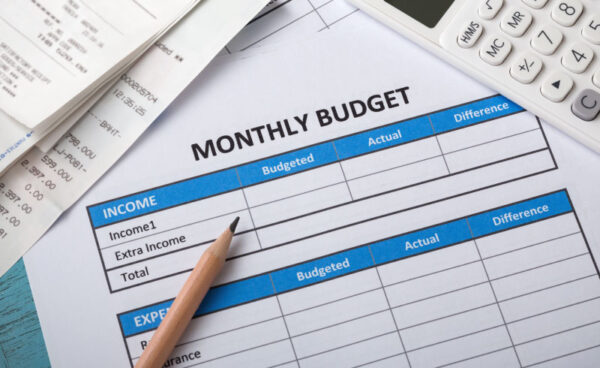5 Things to Consider When Developing a Personal Budget

So you’re ready to grab hold of your finances and control your future. How do you get started? Most people will tell you to stick to a budget, but that’s easier said than done. A high-quality personal budget requires thought and effort to effectively improve your financial health.
To avoid creating an ineffective budget or a plan that’s geared toward a “set it and forget it” mindset, consider the following:
1. The Basics
When you sit down to draft out your personal budget, begin with the basics. These can be broken down into three categories. Each of these sections will be important for you to focus on:
Income
To draw out an accurate budget, you need to know how much money you’re bringing in. If you get paid by the hour, you can do some simple calculations to provide a monthly estimate. You can also look at your past tax records, which state your income for the year. Speaking of taxes, don’t forget to take them into account when calculating how much you have available to spend each month.
Expenses
The next step is to calculate your expenses. Start with the non-negotiables, such as your rent (or mortgage) and insurance. Next move on to expenses that are essential but variable, like groceries and utilities. Discretionary expenses such as clothing purchases, dining out, and monthly subscriptions also deserve a place on your budget. Adding them all up will help you see whether you’re living within your means. If not, it will show you how much you need to adjust in order to do so.
Consider how you pay for things as well. Are you using a credit card and racking up debt? It’s likely that a debit card could help you manage your spending more effectively.
Savings
Having a healthy savings account balance will really help you in a pinch, whether it’s to cover unexpected medical bills or fix a busted pipe. Preparing for retirement is another concern, so plan to add a set amount for savings to your budget. This will help ensure that you don’t spend everything you earn.
A smart way to save is by automating your savings. This funnels a specified amount into your savings account every month so you don’t end up spending it.
One way to break your overall budget down is by following the 50/30/20 rule. This practice tells you to set aside 50% of your income for needs, 30% for wants, and 20% for savings and debt repayments. It’s a simple formula that’s a great place to start for those who are new to budgetering.
2. Your Desires
Let’s talk about that 30% for a minute. Your budget doesn’t have to be a killjoy. You should most certainly enjoy the finer things in life such as pursuing hobbies, traveling, and indulging in the occasional luxury. A budgeting habit is what will keep you in line so you don’t overspend on these non-essentials.
You might have included a few of your desires in your expense list already. It’s fun to go to the movies with friends or pick up a bottle of wine on your way home from work. Including these in your budget simply makes sure you never overdo it.
Label these desires under discretionary spending. Your fixed expenses should always take precedence. Don’t miss a rent payment because you opted to go to a concert instead.
3. Possible Changes
General Dwight D. Eisenhower famously said, “Plans are nothing. Planning is everything.” The same holds true for budgeting.
Rarely will your first budget last for a long time. Don’t get so hung up on your established budget that you’re not willing to make changes when they are needed. In fact, you should review your budget often so you can make changes to it periodically.
For example, you might get a raise at work in the coming weeks. How are you going to distribute that extra income? Up your savings? Rent a better apartment? Eat more fast food? Adjusting your budget as soon as possible will help ensure that you put your extra funds to good use.
You should plan for the inverse effect as well. Medical bills or home repairs will need to make a brief appearance in your budget until they can be paid off. You might have to sacrifice some of your budgeted luxury items or make a concerted effort to find savings elsewhere.
4. Financial Goals
What are your long-term financial goals? What you hope to accomplish with your money in the future will dictate exactly how you construct your budget.
Let’s say you want to save up money to make a down payment on a house. In order to meet this goal, the savings portion of your budget will need to be higher than it would be otherwise. In accordance with that change, your spending columns will need to be adjusted to enable additional savings.
Another goal many Americans have is to rid themselves of debt. How can your budget help you accomplish this? A tight personal budget for a few months can gather up enough money to pay off credit card balances. Smaller adjustments will help you more effectively chip away at your mortgage or car loans, or even pay them off faster than you thought possible.
5. Budgeting Tools
How you manage your budget can be quite the difference-maker. While keeping a physical notebook works for some, there are many tools at your disposal to take your budgeting to the next level.
For starters, your bank and credit card companies likely have their own mobile apps. Download these to your devices so you can monitor your money in real time. You can enter your transactions in a spreadsheet to get a better look at how your budget is doing.
If spreadsheets aren’t your forte, look at some of the other financial apps available to download. Budget trackers and other financial advisory apps can work together to help you use your money the right way.
Get your budget up and running and stick to it closely (until you need to make adjustments, that is). Your financial health will be much improved by having it at your side. You’ll notice the difference as you’re able to slowly build up savings and equity by using a budget to direct your finances.

 Traditional Dress of Kerala: Men & Women’s Attire
Traditional Dress of Kerala: Men & Women’s Attire  Traditional Dress of Goa: Men & Women Styles
Traditional Dress of Goa: Men & Women Styles  Traditional Dress of Nagaland: Styles for Men & Women
Traditional Dress of Nagaland: Styles for Men & Women  BEST PUSH-UP BRAS FOR EVERY BREAST SIZE AND SHAPE
BEST PUSH-UP BRAS FOR EVERY BREAST SIZE AND SHAPE  Swimsuit You Can Wear To A Beach Party
Swimsuit You Can Wear To A Beach Party  How Recruiters are finding the Best Talent
How Recruiters are finding the Best Talent  What Are Minimizer Bras & Benefits of Minimizer Bra
What Are Minimizer Bras & Benefits of Minimizer Bra  Top 10 Best Famous Indian Artists and Their Paintings
Top 10 Best Famous Indian Artists and Their Paintings  Top 10 Famous Badminton Players in India to Know
Top 10 Famous Badminton Players in India to Know